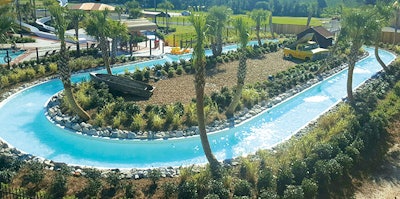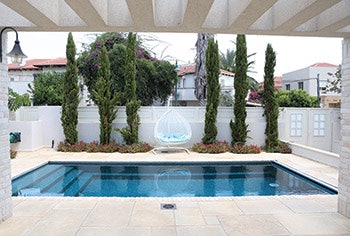
Over the past few months, I've come upon an interesting trend, one that has found its way into the pages of AQUA in three recent articles I've written.
In a nutshell, I've noticed there are some potentially exciting and relatively new ways to build swimming pools that stand as dramatic departures from the familiar triumvirate of shotcrete/gunite, vinyl liner and fiberglass.
 A modular fiberglass lazy river by American Aqua Works.
A modular fiberglass lazy river by American Aqua Works.
PIECE BY PIECE
It started back in our February issue with a feature about bolt-together fiberglass pools. "A Fiberglass Lazy River" looked at lazy rivers built by American Aqua Works, a company that for years has focused on building large fiberglass waterslides. In an innovative twist, the company began using its modular fiberglass slide construction system to build lazy rivers instead.
This grabbed my attention for a couple of reasons: First, lazy rivers have grown in popularity over the past few years, despite the fact that they are expensive and notoriously difficult to build. Nevertheless, builders who specialize in these complex vessels consistently say that both homeowners and commercial clients are willing to pony up the dollars to pay for them.
(It's no coincidence that one of the most popular features we've ever printed, "A (Lazy) River Runs Through It" by Mike Farley, continues to draw strong readership even though it was originally published more than five years ago.)
Now with the American Aqua Works concept, lazy rivers suddenly became more affordable and much simpler to build, which may stoke further demand for these vessels.
RELATED: A (Lazy) River Runs Through It
The other thing I find particularly intriguing is how this system essentially opens up fiberglass pools in general to the idea of modular construction. Ever since they've been on the market, fiberglass pool manufacturers have reported that the limitation in size is how big a shell can be shipped on a truck.
The American Aqua Works concept suggests we might one day be able to build really large fiberglass pools in sections and assemble them onsite. Whether or not that kind of sweeping product evolution takes place industry-wide certainly remains to be seen, but a lazy river made from sections of fiberglass might just push that door open.
 Biodesign USA's sculptural pool design.
Biodesign USA's sculptural pool design.
SCULPTING EDGES
Next, in our May issue I covered a type of pool construction that is truly novel, so much so that it defies categorization. It's a way of building naturally sculpted pools that is nothing like anything I've seen before. It's based on an Italian concept called the Thermapool, which uses a hybrid structure consisting of multiple layers of geotextile material, concrete, vinyl liner and plaster or pebble surfaces laid over the contours of the earth. It's similar in some respects to the way liners in ponds are installed with geotextile and concrete layers, but it's far more robust and now fully adapted to swimming pools.
RELATED: A Groundbreaking Concept
The result is a pool that conforms to the site's topography in ways that are difficult to achieve in traditional gunite pools, often with rolled edges and gradual zero-entry slopes that encompass the entire body of water. The best way to describe these unusual looking pools is "sculptural," but in a way that cleverly embraces the setting. (For the full story, see "A Groundbreaking Concept.")
Biodesign USA is the company pushing the concept here in North America, and its pools are so unusual, it's easy to imagine they would appeal to a particular niche of customer and builder while remaining obscure to others. I personally find it exciting — these pools represent an entirely new category of vessel, or at least a type of pool that is a distinct visual departure from anything that's come before it.
Finally, there's the story in this issue by yours truly covering the S-POOL, a prefabricated concrete pool developed by the company of the same name in Israel. Check out the article in this issue for a detailed description, but for now, I can say it provides another potentially important new wrinkle in pool design — and one that brings us back full circle to the concept of using concrete to contain water.
 The S-Pool.
The S-Pool.
PREFAB DURABILITY
As I was working on the S-POOL story, I couldn't help but wonder why a prefab concrete pool design hasn't happened before. Prefab concrete structures, including those that contain water for other applications, are not a new concept. Yet, as far as I or my other AQUA colleagues know, this is the first time it's been done with swimming pools.
RELATED: A Fiberglass Lazy River
Building concrete shells on site with traditional gunite/shotcrete has been the mainstay of pool construction for more than 100 years — and a lot longer than that if you count pre-Industrial Revolution pools. Concrete is one of the world's most enduring and widely used construction materials, and for good reason. It's relatively simple to make, extremely affordable and malleable compared to stone, earth or wood and it's remarkably durable. (Many cementitious structures created by civilizations including the Egyptians and Romans still stand to this day.)
Comments or thoughts on this article? Please email [email protected]












































